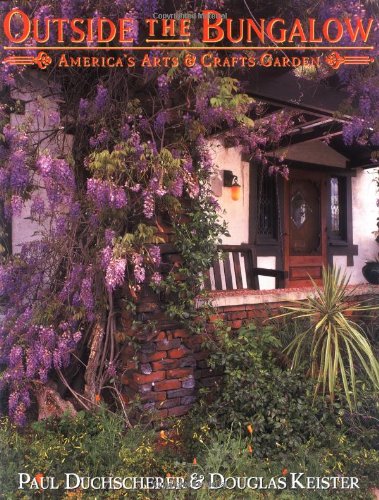This third volume in a popular series highlights the special beauty and enduring appeal of Arts and Crafts bungalow gardens.
Matching Paul Duchscherer’s authoritative text with striking photographs by Douglas Keister–the team that made The Bungalow and Inside the Bungalow so successful–Outside the Bungalow will captivate the ever-growing number of Arts and Crafts aficionados. In it the garden, with its “nature-friendly” charm and character, takes the spotlight as an integral part of bungalow living.
Focusing on the fixed architectural or “hardscape” elements, striking ensembles include entry gates, arbors, portals, and driveways; wooden fences, screens, railings, and masonry walls; paths, walkways, and steps; ponds, fountains, bird baths, swimming pools, and spas; courtyards, patios, gazebos, pergolas, and porches; outdoor furniture from benches to swings; and details from treehouses and potting sheds to lighting and garden accessories. Special chapters feature gardens of the famous Charles and Henry Greene houses, and a turn-of-the-century plant list. Portraits of gardens in context with their vintage bungalows range from glorious color photographs to hand-colored postcards of the period and will thrill architecture or design professionals and amateurs eager to recapture the romance of “bungalowmania.”Open the door and step outside to see how the Arts & Crafts aesthetic has shaped gardens over the years as surely as it has influenced architecture and furniture. This follow-up volume to Inside the Bungalow: America’s Arts and Crafts Interior shows the characteristic brick, tile and wood, wide-porched exteriors of the bungalow style half-buried beneath wisteria vines, arbors, flowers, and foliage.
The bungalows that the gardens surround range from the archetypal dark, timbered wood and stone to the rustic, grand, and even Southwestern, offering a visual feast of gardens to match. The authors emphasize not specific plants, but the architectural elements and style of such gardens: tiled fountains, pergolas, pathways, and the use of stone, timbers, and courtyards to tie house and garden together.
Both text and photos focus in on details like outdoor light fixtures, hose bibs, mailboxes, birdhouses, fences and lattice as part of the characteristic Arts & Crafts aesthetic. The “Garden Portraits” chapter includes garden plans as well as photos of bungalow exteriors from Seattle to southern California, emphasizing that it is not the plants themselves but how they are grouped to emphasize the architecture and the hardscaping that creates an Arts & Crafts garden. Still, there are certain plants that appear over and over again in the photos, and have the right look for such gardens–ornamental grasses, vines, climbing roses, and plants with bold structural foliage like iris, ferns, clivia, and hosta. The charming chapter on potting sheds and tree houses, as well as the exuberant and colorful plantings throughout, go a long way toward explaining why people have been so captivated by “bungalowmania” for more than three decades. –Valerie Easton






Unique style beautifully presented This book covers the architectural aspects of the property surrounding the bungalow – gates, arbors, fences, walls, paths, steps, water features, courtyards, patios, pergolas, porches, outdoor furniture, etc. The photography and color illustrations are superb and it is hard to take your eyes off the photos to actually read the text! And although the photos were taken at the present, the authors have not neglected the history of these dwellings and have included beautiful colored postcards that were so popular during the 1920s and 1930s. An introductory sections discusses the movers and shakers of the Arts and Crafts Movement, like William Morris, William Robinson, Gertrude Jekyll and Gustav Stickley. The final chapter is devoted to the architectural firm of Greene and Greene, whose style was a major influence. Most of the houses and gardens photographed here are on the West Coast (mainly Seattle, WA, Portland, OR and Pasadena, CA) although there are some Rhode Island properties included as well. A final section is devoted to planting the garden and includes lists of plants which are good for any situation imaginable. This is a wonderful book – beautiful, unique and inspiring!
Excellent resource for creating a “complete” environment What a great resource for those who feel that their home begins outside in its surroundings. The bungalow has never really gone out of style and continues to hold national appeal. This book is full of ideas that cross the spectrum from simple to ellegant. It draws the reader outside of the bungalow and gives one cause to reflect on making the outside environment beautiful, comfortable, unique and completmentary to the structure itself. Many of the small towns in Southern California have undergone a second life with downtown revitalization projects that have extented into the older neighborhoods. Duchscherer & Keister give the reader an appreciation for the beauty that can be created around these older homes.
Great Information for the Restorer This is an excellent guide for the person that is considering restoring a bungalow, not just a gardener . The pictures show many outside amenities including walkways, doors, fencing, lighting, and porches. Great source for ideas and models.
Comments are disabled for this post.